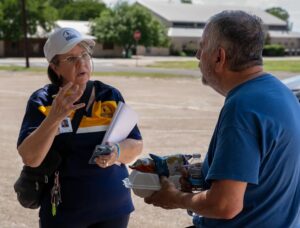
 There has been a great deal of emphasis in our Convention recently regarding church planting. The International Mission Board is talking about it. The North American Mission Board is talking about it. Our seven Southern Baptist seminaries offer courses in church planting and have professors of church planting. Our state conventions are talking about it. Our associations are talking about it. Some of our churches are even involved in planting churches. We are the largest non-Catholic, Christian denomination in the world. We consist of more than 16.2 million members and more than forty-three thousand churches. Do we really need another Southern Baptist church?
There has been a great deal of emphasis in our Convention recently regarding church planting. The International Mission Board is talking about it. The North American Mission Board is talking about it. Our seven Southern Baptist seminaries offer courses in church planting and have professors of church planting. Our state conventions are talking about it. Our associations are talking about it. Some of our churches are even involved in planting churches. We are the largest non-Catholic, Christian denomination in the world. We consist of more than 16.2 million members and more than forty-three thousand churches. Do we really need another Southern Baptist church?
Let's consider the evidence, and you can decide.
Biblical Evidence
In Matthew 28 and Acts 1, Jesus commanded His followers to go and make disciples throughout the entire world. As they went on mission, they were to baptize and teach. The book of Acts shows the outplaying of Jesus' command to His followers. The disciples went throughout Jerusalem, Judea, Samaria, and various parts of the known world. Because of the faithfulness of the early disciples, churches were planted in Jerusalem, Antioch, Philippi, Rome, Colossae, Berea, Corinth, Laodicea, Thessalonica, Ephesus, Sardis, Philadelphia, Pergamum, Thyatira, Smyrna, and numerous other cities scattered throughout the Roman Empire.
In fact, the Apostle Paul desired to travel to Spain (Romans 15:24) because he believed that the gospel had been preached, churches had been planted, and would, therefore, continue to carry out the Great Commission in their Jerusalem, Judea, Samaria, and throughout the world. For Paul, there was no other place for him to preach; therefore, he desired to go to a new territory (Romans 15:19, 23) to repeat his pattern.
Historical Evidence
It was because of the faithfulness of the early disciples to carry out the commands of Christ through church planting that I am able to write this article and that you are able to read it. As the gospel was preached throughout the centuries, churches were planted that carried out their missionary tasks. Because of a long chain of obedient disciples, the gospel finally arrived on the shores of our continent, churches were planted, and centuries later you and I came to follow Christ.
We have come to know the Lord through the faithfulness of those who have gone before us over the centuries — those who have sacrificed so that we could hear and respond to the gospel. And churches engaged in church planting stand on the shoulders of those faithful ones.
The church that says, "Yes, we will plant churches!" is the church that boldly declares, "We will not close the door on centuries of church history. We will not allow the faithfulness and sacrifice of our brothers and sisters to end with us. We will look beyond ourselves, if the Lord tarries, to a future generation who will need this same gospel!"
Demographic Evidence
As of 2004, the estimated population of the United States was 293 million, and Canada was thirty-three million.1 These numbers, of course, increase when you factor in all of those who live here temporarily (legally or illegally). There are more than 386 thousand churches of all types in the United States and more than twenty-two thousand in Canada.2
This means that there is roughly one church — orthodox or heretical — for every 800 people in North America.3 In particular, there is no Southern Baptist church in Newfoundland, and less than 250 Southern Baptist churches in the entire nation of Canada! Even more surprising, recent reports from Western Canada have revealed that there are towns with populations as high as one thousand without a single church of any kind!
Consider the following statistics: It is estimated that the unchurched populations of the United States and Canada are 195 million and twenty-four million, respectively. From the mid-1980s to the mid-1990s, the population in the United States increased 11.4 percent, but the overall church membership declined 9.5 percent. Less than 5 percent of all Canadians could be identified as evangelical.4
Cultural Evidence
Without going into too much detail showing the ethnic diversity in North America, we should note that 28 percent of all Canadians originated from the British Isles, 23 percent are of French origin, 15 percent are "other" European, and 2 percent are Amerindian (not to mention those of numerous Asian, African, and Arab backgrounds).5 Though 77 percent of the United States is considered white and 13 percent black, there are also large populations of Hispanics, Asians, Africans, and Arabs.6 Though these statistics help paint a picture of the ethnic landscape, they do not tell us about vast cultural differences found within any given ethnic group. These numbers tell us nothing regarding the ways people communicate, learn, organize themselves into groups, and interact with one another — all very important elements to understand in church life.
No church can reach everyone in its community. A church tends to reach people of the same, or slightly different, culture as its members. Culture is a powerful force, affecting the way people interact and see the world. North America is one of the most culturally diverse continents on the planet. Instead of looking at our cities as black and white, or rich and poor, we need to see the great diversity that is before us and reach the segment that we are best equipped to reach.
Denominational Evidence
Denominations that do not plant churches today will cease to exist tomorrow. Approximately seventy-two North American churches cease to exist at the end of every week. The fact is that churches go through a life cycle; many of those churches do not turn around and eventually cease being the church in their geographical area. Over 70 percent of Southern Baptist churches are either plateaued or declining. Church planting is a way to change the present reality.
For example, the North American Mission Board (NAMB) helped plant a record-high 1,781 churches (4.9 churches planted per day) in 2004 (59 percent were non-Anglo churches). NAMB also has established the goal of helping engage 6,300 Southern Baptist churches in church planting efforts by the end of 2005, and to enlist eleven thousand Southern Baptist churches in church planting efforts by 2010.
Historically, Baptists have seen the importance of church planting. In the early days of the United States, it was the Baptist farmer-preacher who both pioneered the land and planted churches, especially near creeks and rivers, where he and his family settled. For Southern Baptists to give up on church planting is to forsake a foundational component of our Baptist heritage.
Evangelistic Evidence
Church growth expert C. Peter Wagner wrote that the "single-most effective evangelistic methodology under heaven is planting new churches."7 Various studies have shown that, for the most part, younger churches have higher baptism rates than older churches.
An article in Christianity Today cited Bruce McNicol as reporting that among evangelical churches, those under three years in age reach, on-average, ten people for Christ for every one hundred members in a given year. Churches who are between three years old and fifteen years old will reach five people per year. Churches over fifteen years old will reach three people per year. According to the article, "90 percent of all churches reach their peak in attendance, outreach, and giving by their twelfth birthday."8 In a study of Anglo churches from 1987-89 it was discovered that the new churches baptized thirteen people for every 100 members compared to established Anglo churches who baptized three people for every 100 members.9 In another study, it was noted that churches ten years old or older average 2.5 baptisms per year per 100 members, and churches ten years old or younger average 10.8 baptisms per year per 100 members.10
Typically, there is a vitality and evangelistic enthusiasm found in newer churches. They have not had time to develop the structures and organization that frequently lead them to redirect time and energy toward a maintenance mode. Therefore, their missional zeal remains high.
Religious Evidence
North America has become a very diverse religious landscape, and growth among our churches has not kept up with the changes. On the other hand, cults and other world religions are growing at a very rapid rate. Aubrey Malphurs noted in his book on church planting that the Mormons have tripled in size between 1965-2001 in the United States and that the Jehovah's Witnesses did likewise in Canada.11 Christianity grew by 5 percent from 1990-2000 in the United States, but compare this with the following growth rates:
• Nonreligious/Secular: 110 percent increase
• Islam: 109 percent increase
• Buddhism: 170 percent increase
• Hinduism: 237 percent increase
• Unitarian/Universalist: 25 percent increase
• Native American: 119 percent increase
• Baha'I: 200 percent increase
• New Age: 240 percent increase
• Sikhism: 338 percent increase
• Scientology: 22 percent increase
• Taoism: 74 percent increase
v Deism: 717 percent increase12
Economic Evidence
Though some church planting is very expensive, a costly endeavor is not always necessary. If we look to God's Word for our definition of "church," very few financial resources may be needed to plant a church. Despite popular opinion, church planting is evangelism that results in congregations and can be one of the most inexpensive evangelistic ministries of our churches. Not only does church planting have the potential for significant evangelistic results, it also is a very wise stewardship of our finances for Kingdom work.
Conclusion
While some might dismiss the notion of starting new churches as unnecessary or wasteful, the fact remains that we still have an obligation to start new churches. The evidence supports it, God has clearly blessed it, and the world desperately needs it. The question that remains is:
"Are we willing to invest our lives and ministries in such a noble cause?"
1 https://www.odci.gov/cia/publications/factbook/index.html.
2 https://www.americanchurchlists.com.
3 One for every 759 people in the U.S. and one for every 1,500 people in Canada.
4 North American Mission Board, New Churches Needed: Our Church Can Help! A Step-by-Step Handbook for Planting New Churches (Alpharetta, GA: North American Mission Board, 2001.), p. iv.
5 https://www.odci.gov/cia/publications/factbook/geos/ca.html.
6 https://www.odci.gov/cia/publications/factbook/geos/us.html.
7 C. Peter Wagner, Church Planting for a Greater Harvest (Ventura, CA: Regal Books, 1990), p. 11.
8 "Churches Die with Dignity," Christianity Today (January 14, 1991), p. 69.
9 Charles Chaney, "New Churches and the Unsaved," Mission USA (January-February 1995), p. 12.
10 North American Mission Board, New Churches Needed: Our Church Can Help! A Step-by-Step Handbook for Planting New Churches (Alpharetta, GA: North American Mission Board, 2001.), p. 55.
11 Aubrey Malphurs, Planting Growing Churches for the 21st Century, 3rd ed. (Grand Rapids, MI: Baker Books, 2004), p. 38.
12 https://www.adherents.com/rel_USA.html.
Church Planting Stats
In the five year history of the Nehemiah Project, NAMB's strategy for equipping church planters through the six SBC seminaries, 592 long-term church planters have been trained and equipped through the Project.
Over the past five years of the Nehemiah Project, more than 400 churches were started by Nehemiah trained planters — an average of 100 per year.
In the history of the Nehemiah Project, 920 Short-term and Semester Student Interns have been involved in church planting.
In 2004, NAMB helped start a record-high 1,781 new churches, of which 59 percent were non-Anglo.
NAMB's goal by the end of 2005 is to help 6,300 Southern Baptist churches become engaged in church-planting efforts.
NAMB's goal by 2010 is to enlist 11,000 Southern Baptist churches in church planting.
Areas in North American of the greatest need for churches: 1) Canada; 2) Northwestern United States; 3) Northeastern United States.














